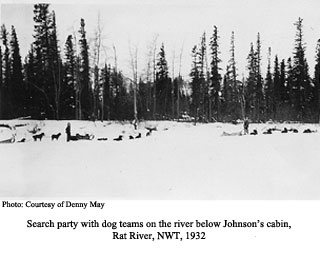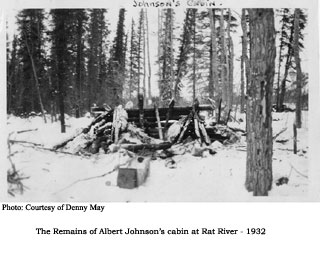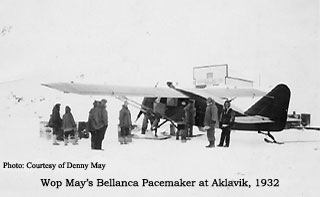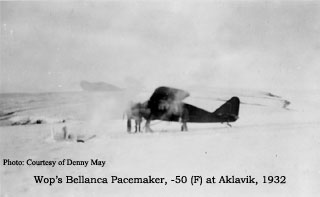|






|
The
Trapper Johnson Story
(As told by "Wop" May to the 12th Calgary Scout Troop
- February 19, 1952)
....."Finally
I was called to go up and take part in the search. The first thing
I had to do was to get them supplied with dog food, dried fish and
then get their food stocks up. Where they had the camp at that time
it was on top of a bald headed mountain, well there were no trees
there, anyway, it was more or less bare land. The district they
were in was just east of the Yukon border. We got them all supplied
and then started to try to find, to track Johnson down, to try to
find him.. It was very hard to see as there was no sun if you know
what the light is like with no visibility and no sun, you can't
see anything, everything is white and it was very hard to pick up
anything, you couldn't pick up his tracks, although we did see some
of his tracks, very few of them. His tracks could be seen in one
place tonight and then tomorrow morning they would be seen 20 or
30 miles away. He travelled that distance in one night, sometimes
he would go straight as a die. Anyway, we looked and looked and
we flew low over every inch of the country that he could be, we
were hoping he would fire at us, he wouldn't have hit us anyway,
but we wanted him to disclose his position, but he was too wise
for that, he wouldn't do it.
Finally
it was just the time that the sun came up, the first day, I think,
the sun appeared and it was shining on this mountain that was behind
where we were working towards the Yukon which is the range of mountains
which is the Yukon and N.W.T. boundary and the sun just hit the
mountain and it would show up very clearly then and I just happened
to get a glimpse of what I thought was a track going over the pass
of this mountain. I went in closer to get a better look at it and
sure enough it was a snowshoe trail. I went over the other side,
on the Yukon side about 75 or 100 miles. We were now on the Yukon
into La Pierre House.
La
Pierre House was a place that in the olden days it used to take
eight years to get supplies in to La Pierre House and get the furs
back. Today you could do it in about 8 hours, you could certainly
do it in 8 days be regular methods now. Quite a historic place.
He had been there but when he crossed the Yukon the snow was much
deeper than it was on the N.W.T. side. The snow over there is packed
hard and you could walk on it very easily except when you got into
sheltered places. Over there he had a hard time and he was slowing
down ,you could see where he was slowing down from his tracks, from
the stops his made and from his tracks, he was not going straight.
We
got the dog teams and the police moved over to La Pierre House.
Then at that time I went out scouting again to try and pick up his
tracks. I did pick up one set of tracks. He was fooling us actually,
I'll tell you about this, he was using the Caribou trail, running
along the centre of the river, the Caribou are by the hundreds of
thousands there and when they start making a trail and going someplace
it's just like pigs, they have a regular sidewalk. He had taken
his snowshoes off and was following this Caribou trail so that we
couldn't trace him, track him.. I did notice though that one place
he had gone up to camp at the side of the river. He was then on
the Eagle River. I gave the location to the Dog Team then Inspector
Eames and he took a short cut and the next morning we were after
him. They left early in the morning and I could not get out as early
as I wanted to because of the fog.
Actually
we all met at the same place. I was up overhead when Alex Eames was
coming round the bend of the river and Johnson was in the middle of
the river. He tried to run up the bank to get out of his way, he didn't
have his snowshoes on, he couldn't make it so he came back into the
centre of the river, dug himself into the snow and the fight started
We
were up on top and circling, watching the fight and taking pictures
of it. I then saw, during the fight, that one man was hit, he was
laying by his dog team and he had been hit so I came around the bend
of the river and came up to him and picked him up and started back
home. He was badly hit. That was a chap named Hersey. He was kneeling
when he was firing - it came through his elbow, out his elbow, through
his knee, out his knee and in his arm, out his arm, just missed his
heart, went right through him and the bullet was lodged just under
his arm at the back. He was in bad shape and the blood was just spurtin'
out and there was nothing we could do for him but get him in the aircraft
and get him back to Aklavik where there was a hospital and a Doctor.
We got him back there, but going through, as we hit the mountains
there was a very heavy snow storm . If I hadn't have known, if I hadn't
have been through there probably about a hundred times I wouldn't
have known I'd have never got through because I knew practically every
stone, every turn in that pass and I was fortunate enough, with the
help I was telling you about (God) to get through to Aklavik, and
the Doctor said if we had been fifteen minutes later that Hersey would
have died.
Well,
that was it, we went back then and we picked up the some of the police
and picked up Johnson and brought him back to Aklavik. They never
found out who this chap Johnson was, whatever his name was. He had
about $2,400 in cash on him, he some pearls with him, he had a lot
of gold teeth that he'd knocked the teeth out of out and kept the
gold the bridge work, and he had a lot of pearls and a lot of fine
gold too. Nothing was ever found out about the man, so they just buried
him at Aklavik."
In
answer to a question he replied: "the last time I looked at him
he had about fifteen or twenty bullet holes in him. We've got one
of them at home, haven't we". (the last question to was his son
Denny)
|